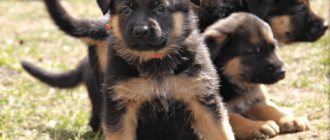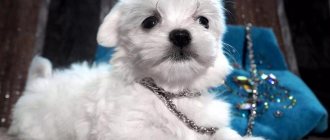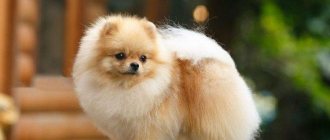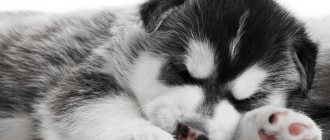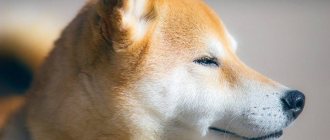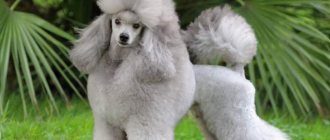A Scottish fold and straight-eared cat at 1 month (4 weeks) is a small creature that needs its mother. Unscrupulous breeders may already give kittens to future owners at this age, because... they want to get their pet early. But such people forget that taking a kitten away from its mother at 1 month is an unacceptable barbarity that can ruin its entire life. In this article we will talk about how a Scottish kitten should look, behave and eat at 1 month old, how to care for it and why it is so important not to separate it from its mother.
The article is part of the section Development of Scottish kittens by month
Advantages and disadvantages
The positive qualities of an animal include its character: the cat has a calm disposition and is friendly.
The Scotsman is hospitable and treats people with respect. The Scots, thanks to their extraordinary intelligence, are easy to train; their courage allows the animals to perform at various exhibitions. A cat can be taught to give a paw, walk on its hind legs, and perform simple tricks.
Fold cats easily learn to use the litter box and tolerate water treatments. Some individuals happily swim in open water sources.
One of the disadvantages is the price of the breed. If you are going to purchase a purebred animal, you will have to shell out an amount of up to 40 thousand rubles. Cats without a pedigree are much cheaper, about 4 thousand rubles, but this does not guarantee that they will sell you a Scotsman and not an animal with surgery performed on the ears. Moreover, such individuals may experience serious health problems in the future.
Other disadvantages include the health of purebred cats. Some Scots suffer from osteochondroplasia. This is a hereditary disease associated with damage to the bone tissue of the joints, cartilage, and manifests itself as a slowdown in bone growth. This disease can be fatal.
Other common diseases of Scottish Folds: chondrodystrophy, arthritis, arthrosis. These diseases usually occur due to improper mating of animals. Therefore, before buying an animal, you should carefully study the pedigree of the animal, right down to the cat’s ancestors. Scots may also suffer from entropion. Adult animals are susceptible to the development of glaucoma and cataracts.
Like all animals, the fold-eared breed may show signs of allergies, mange, or skin eczema. Deafness is also an eternal companion of the breed; it can be complete or partial. Diseases of the cardiovascular and digestive systems, and the bladder develop in old animals or when the cat is not properly cared for.
What the owner should know
In order for the offspring to be healthy, you need to know some features of mating Scottish Folds:
You need to select a partner of a similar breed, that is, Scottish, but not Scottish Fold. In this case, the best option would be Scottish Straight. This breed of cat has straight ears. If a Scottish straight-eared cat is mated, then the opposite is true, the cat must be fold-eared.
You cannot cross a Scotsman with a British breed. In this case, the cubs are too large, the tail and head are deformed, and the structure of the coat does not meet the standards.
The male must have a uniform color, good quality coat, and a proportional build. You should definitely pay attention to the tail, it must be flexible. This factor affects the health of the animal’s spine. This way, developmental defects in the baby can be avoided.
You should also pay attention to the cat's ears. It would be correct if they are directed forward, small, widely spaced and do not go beyond the head
An important feature is the ear folds, it is very good if they exist. Such breeds are considered unique
It is best if there are two of them, and they are tightly folded on the head. It is very rare to meet a Scot who has three such folds.
It is important to assess the health of the male; he should not have dandruff or any discharge from the eyes, nose or ears. The animal should not be emaciated or too large, everything should be within normal limits.
shutterstock
Many owners of Scottish cats begin to look for a partner through advertisements. This method is not bad; you can select a suitable candidate. But there is another simple way: breeder clubs that specialize in Scottish Folds. The specialists working there will be able to help you choose a suitable male and tell you about his characteristics. By choosing this method of mating, you can be sure of healthy offspring.
Before mating, it is advisable to agree on the amount of the cat’s owner’s fee. He usually gets one baby, which has straight ears. There are always fewer fold-eared kittens; it very rarely happens that all the cubs from one litter are straight. If this is the case, then the cat’s owner receives money as a reward. The amount is equal to the cost of a Scottish Fold kitten.
Before mating, it is advisable to personally make sure that both partners are treated for worms and other parasites. It is permissible to treat the cat before intercourse for diseases such as rabies, chlamydia and other diseases, as well as to prevent worms.
The room where the whole process takes place must be clean, bright, dry and spacious, and it must be warm. The intercourse of animals can last several days, so you need to be prepared for the trip. You need to take with you a tray with filler, bowls for food and water, and the food itself. It happens that a cat is very aggressive, so before mating you need to trim its claws.
Your cat may not get pregnant the first time. In this case, it is necessary to bring her to the cat on the 2-3rd day of the next estrus and leave her there for a couple of days. In one day, a cat can cover a female up to 14 times, but after a few days he ceases to be interested in her.
On the eve of childbirth
Usually a woman in labor copes with childbirth on her own, but a responsible owner should keep ready everything that may be useful during childbirth: clean towels, disposable diapers and gauze napkins, scissors and thick threads in case you have to cut the umbilical cord yourself, boiled water and a first aid kit, the contents of which should be discussed with your veterinarian in advance.
If your pet is constantly being observed by the same doctor, ask him for a phone number before giving birth in case of unforeseen circumstances or find contacts of a veterinary hospital where 24-hour consultation is available. Also make sure that you can go to the nearest veterinary clinic at any time, which is always open and you know the way to it and its exact address, in case you have to get there by taxi or on your own.
Childbirth is a moment of crisis for any cat and requires control from the owner
If a cat gives birth safely at home, she will eat the afterbirth after the kittens - this is absolutely normal. Some experts believe that it is enough to give the cat the afterbirth of only one kitten - especially if she has problems with the gastrointestinal tract. By the way, if the labor is long, then it is allowed to feed and water the woman in labor - this will give her strength. After giving birth, you need to clean the nest and leave the cat alone - she will have to carefully lick and feed each kitten.
Loss of characteristic: when the ears rise
Straight-eared kittens are called straights, and fold-eared kittens are called folds. The clear difference between them lies in the presence and number of folds on the ears. One fold causes the ears to straighten over time. This does not mean that the kitten is straight. To answer the question about his breed, an examination is carried out. It is especially important for owners who plan to crossbreed kittens. An incorrect conclusion about the straightness of an animal leads to the crossing of two lop-eared individuals and sick offspring. If there are two folds, then it is impossible to predict the outcome: the kitten can remain fold-eared with the same success as become straight-eared. Three folds ensure the ears don't straighten out.
External differences between British and Scottish cats
Folds with erect ears are sterilized to prevent the transmission of a dominant gene that has lost visual expression.
There is a clear sign that distinguishes a fold-eared cat with erect ears from a straight-eared one: the size of the ears. The first one has smaller ones.
Temporary changes in the position of the ears are also possible, the cause of which is weather conditions. The heat causes the Fold's ears to rise slightly.
In addition, the ears of the folds also rise in females after giving birth.
How to distinguish a straight-eared cat from a fold-eared one with erect ears?
As we have already said, sometimes over time a lop-eared kitten's ears will rise. Why can cats' ears go up? This is influenced by various factors, including the number of folds. As a result, if a fold's ears rise, it may be considered a straight. This is not particularly important if you do not intend to crossbreed your pet. But if there are such plans, you will have to conduct a genetic examination: folds cannot be crossed with folds, therefore, if your cat is a fold, and you, thinking that he is a straight, pair a fold, the offspring will be sick. At the same time, it is recommended to neuter Folds with mature ears.
Character of the breed and behavioral characteristics of Scottish Fold cats.
Cats of this breed are very kind and calm, but also do not allow themselves to be offended. Typically, a fold-eared cat becomes attached to only one owner, expressing this with his affection.
She is quite independent and discreet, and is ideal for those people who are often busy at work and are rarely at home. Due to its reserve, it does not have the playfulness that children so often need, so if you plan to have a pet for a child, it is better to choose a more active and mischievous breed.
They also cannot stand loud noise in the house and love silence and comfort. They meow very rarely, mainly when they really need something, for example, if the bowl is empty.
They have one peculiarity: they can stand on their hind legs for a long time and if they are interested in something, they can watch it for a long time, taking a meerkat pose. It is also interesting that they know how to sit in the Buddha pose when they rest on a bed or on upholstered furniture.
If there are other pets in the house, fold-eared cats will happily make friends with them. They get along well even with dogs.
These are non-conflict animals and can easily endure both trips to exhibitions and visits to the veterinarian.
The only thing they don’t like is guests or strangers in the apartment. In such situations, the fold-eared cat will prefer to hide in another room.
- Calmness and lack of conflict (on the street you rarely see a Scottish Fold fighting with other cats);
- Patience (if the owner is absent for a long time, the pet will not be very nervous, and at the time of feeding it will not meow much);
- Attachment (they get used to the owner and place of residence quite quickly);
- Independence and independence (very rarely they ask the owner for anything and do not bother with whims);
- Moderate emotionality and playfulness;
- Curiosity;
- Intelligence and grace (they are quite smart and if teased, they will prefer to ignore ill-mannered people or animals rather than respond with aggression).
Scottish Folds are an exclusively domestic breed, as they were bred and kept in appropriate conditions. Despite the calmness and lack of aggression, these animals still know how to hunt.
The hunting instinct allows you to easily catch small rodents and large insects.
These animals are amazingly smart and intelligent. They are able to differentiate the information they receive and select only the information they need.
Thanks to this, they are easy to learn and train. The voice and sounds that folds make are not quite like meowing. But this is not a drawback at all, but a distinctive feature of this amazing species.
External factors
Now let's figure out how to choose a real Scottish kitten. Very often, under the guise of Scots, they sell British or even mongrel children. Before you make a purchase, it’s worth visiting specialized nurseries to get an idea of what Scottish Fold kittens might look like.
Let us note the main external signs of the Scots:
- the fur is short, as if plush;
- very reminiscent of little bear cubs;
- the eyes are round and large, slightly slanted;
- the head looks like a fur ball;
- folds have drooping ears, while straights have straight ears;
- if you look from the side, the mouth “smiles”;
- neat nose;
- ideal representatives of the breed have a “childish” face;
- Parents of children should also have pedigrees.
Scottish cats can come in different colors: you can find black, white “teddy bear” cats, as well as cream, blue and even red. There are a huge number of coat patterns, such as brindle, spotted. There are representatives who have a mixture of colors and patterns.
Determining gender in other ways
There are several other methods for determining whether a kitten belongs to one gender or another. Below we will look at which are reliable and to what extent.
By color
A very reliable method if we are talking about a tortoiseshell kitten: black, blue-cream or patchwork (tri-color) “tortoise”. A tortoiseshell kitten is 99% of the time a cat. This is explained by the fact that all colors without exception are formed by two genes - “black” and “red” (red). Blue and cream colors are “lightened” blacks and reds.
The color gene is always transmitted by the female X chromosome, so there can be no discrepancies in cats: XY - one color, black or red, transmitted by the mother. Cats have two chromosomes carrying color genes: XX - therefore, it is possible to transmit either red or black genes, or both at the same time, which gives the tortoiseshell color.
Tortoiseshell boys are born very rarely, and their color is a genetic deviation (extra X chromosome: XXY - giving the wrong second color gene). Therefore, “tri-colored” cats are born sterile. All other colors are normal for both sexes.
By voice
With a certain stretch, one can consider the method effective: it is believed that cats have more low overtones in their voices, and cats have more high ones. In fact, quite a few cats have a rather gentle contralto voice, and the voices of some cats, on the contrary, sound menacing and not at all feminine.
In the face
It is believed that the outlines of the girl’s face are more subtle and soft, while the “portrait” of the cat is sculpted roughly, with wider cheekbones and the back of the nose. In reality, the method, of course, cannot be considered reliable. “Facial features,” like in humans, are inherited from parents. Which makes it more than likely both the subtle aristocratic features of the cat’s appearance and the harsh features of some four-legged young ladies.
Moreover, there are breeds of cats (a striking example is the Maine Coon), whose breed phenotype obliges them to look like wild, angry predators, regardless of gender. There are also breeds of graceful, fine-boned cats, the characteristics of which are reflected in the features of the males enough to confuse the untrained eye.
By weight
Weight is a criterion by which it is theoretically possible to determine the sex of an animal, but the reliability of the method is very low. It can be considered more or less reliable in two cases:
- If daily control weighings of the litter show a consistently high weight gain of some kittens compared to others (indicators vary for different breeds and individual body characteristics of animals).
- If size and weight are breed-forming characteristics and significantly exceed the values possible for cats, with a high degree of probability the luxurious dimensions belong to the representative of the stronger half. The disadvantage of this method is that by the time they reach the indicative size and weight, the animals have already grown enough to easily determine gender based on anatomical characteristics.
Veterinary method
You can accurately find out the gender of a kitten by contacting a veterinary clinic. If a visual examination by an experienced veterinarian does not allow accurate results (for example, when the length and thickness of a very small kitten’s fur “confuses the indications”), there is always the opportunity to donate blood for a test. It makes sense to resort to this method when it is the only way, and for some reason the result needs to be known urgently.
Body weight gain chart
For any breed of cat, including Scottish, there is a table that shows changes in the weight of animals depending on age and gender. In the table, this indicator is usually given up to a year. For the Scots it looks like this:
| Scottish kitten age | Weight for a cat, kg | Weight for a cat, kg |
| Newborn kitten | 0.06-0.14 | 0.07-0.14 |
| 1st week | 0.11-0.25 | 0.24-0.26 |
| 2nd week | 0.14-0.36 | 0.34-0.4 |
| 3rd week | 0.2-0.42 | 0.39-0.63 |
| 1 month | 0.24-0.6 | 0.54-0.74 |
| 2 months | 0.4-0.9 | 1.0-1.7 |
| 3 months | 1.0-1.5 | 1.5-2.5 |
| 4 months | 1.7-2.4 | 2.1-3.9 |
| 5 months | 2.2-2.9 | 2.6-4.3 |
| 6 months | 2.3-3.6 | 3.0-5.4 |
| 7 months | 2.4-3.9 | 3.3-5.6 |
| 8 months | 2.5-4.1 | 3.5-6.0 |
| 9 months | 2.5-4.3 | 3.8-6.4 |
| 10 months | 2.5-4.4 | 4.1-6.7 |
| 11 months | 2.5-4.5 | 4.3-6.8 |
| 12 months/1 year | 2.5-4.6 | 4.5-7.0 |
As already noted, at the age of 4–6 months, Scottish Folds and Straight-eared cats become teenagers. At this age, cats are already in heat. These animals grow up to 2–2.5 years. Before the growth period ends, pets manage to gain about 500–700 g more and their final weight is about 6–9 kg. Therefore, until the age of 2.5 years, you need to carefully monitor your pet’s weight so that it grows up healthy and well-developed.
You can determine how much a newborn pet already weighs using ordinary kitchen scales. Older individuals are weighed on floor scales. After weighing, the weight is compared with the table readings and it is determined whether weight gain is proceeding normally.
UNTIL WHAT AGE WILL KITTENS REMAIN BABIES? HOW MANY MONTHS WILL THE KITTEN BE A KITTEN?
Determining the age of a kitten: if you want to determine the age of a kitten based on external data and characteristics, carefully study the table and find the characteristics that match your pet. Determining how many months a kitten is is quite simple, because a kitten changes a lot every month. Here are the characteristics that you should pay attention to to find out how many months a kitten is: weight and size of kittens by month, teeth (baby, permanent, or during the period of teeth change), fur and undercoat, eye color, behavior. So how do you find out the age of a kitten? Read the description in the table and compare!
Also, how to find out how many months a kitten is and how to determine the age of a kitten will be helped by a photo.
Buying Scottish Fold, how to buy correctly?
- The kitten's ears should fit snugly to the head;
- The head should be round and the coat plush and soft;
- The kitten's gait and movements should be smooth and flexible (fold-eared cats may have diseases of the musculoskeletal system at the genetic level, which can occur when these animals are improperly crossed);
- The tail should be flexible and not very long;
It is recommended to buy kittens from trusted nurseries, where crossing is carried out according to all the rules for breeding this breed.
When buying an animal from unknown people, there is a risk of developing joint diseases in the future, due to possible unscrupulous compliance by these people with the conditions of crossing its ancestors.
- Single fold ears (if only the ends of the ears are bent);
- Double fold (the ears bend entirely at the base of the auricle, leaving a small gap between the ears and the head);
- Triple fold (complete fit of the ears to the head).
The coat color of cats can be either monochromatic or with a variety of color shades.
Breeders' advice
Breeders are reminded that the Scottish Fold cat can be very different. In one litter, both Scottish Straights (with straight ears) and Scottish Folds (with envelope ears) are born.
Moreover, both varieties can have not short, but semi-long hair. Then they will be called Highland Straights (Scottish Straight Longhair) or Highland Folds (Scottish Fold Longhair).
Lop-eared and straight-eared
Scottish Straights differ from their fold-eared relatives only in the position of their ears, maintaining the indescribable charm of the breed as a whole - they, like Folds, are round-eyed, respectable and charming. Breeding work with the Scottish Fold is full of surprises, since mating occurs exclusively between fold and straight.
With a 50/50 probability, a straight-eared cat can produce fold-eared offspring. In practice, the distribution of straight-eared and fold-eared babies in one litter cannot be planned: sometimes all newborns have envelope ears, sometimes the entire litter is decorated with straight ears.
Short-haired and long-haired
Short-haired animals have a soft, but quite dense coat, reminiscent of plush to the touch. Highlands (with long hair) can be born from both long-haired and short-haired sires (if they have the recessive gene for long hair).
The Highland coat cannot be cottony (this is considered a flaw), but must be silky and airy, not matting and requiring almost no maintenance.
The abundant fur of the “Scots” does not spoil, but even more accentuates their rounded head and expressive round eyes
Nutrition
The Scottish Fold kitten must eat properly. Since representatives of this breed have a tendency to quickly gain weight, their portions should be limited from childhood and their diet should be controlled so that it is complete. Many owners, after acquiring fluffies, prefer to give them the food that was used in the nursery, but this is wrong. When preparing your diet, you should consider the following recommendations:
- You can feed Scottish Folds only with natural food intended exclusively for cats;
- It is allowed to add canned foods, wet mixtures and dry food to your pet’s daily diet;
- You can periodically combine natural food with artificial food.
When feeding your kitten canned foods, you need to remember that they should not contain dyes or preservatives. Supplements in the form of beneficial microelements and vitamins will also not hurt your baby. Prohibited products include:
- legumes;
- raw fish;
- potato;
- all types of herbs and spices.
Recommended products include:
- boiled or raw vegetables;
- dietary meat of rabbit, chicken and turkey (it is pre-boiled and chopped);
- low-fat fermented milk products;
- sea fish (deboned and boiled);
- all types of cereals mixed in equal proportions with fish or meat.
Adding to the family: how to care for a mother and her newborns
In the first weeks after the birth of kittens, providing proper care is the key to healthy babies and cats. The list of necessary actions on the part of the owners is as follows:
- Provide a warm, dry box for mother and kittens.
- Place a white sheet over it to help track your cat's waste.
- Provide your cat with a balanced diet.
- Organize constant access to water for babies and mothers.
- Do not try to separate the kittens from the cat.
The last point determines the development of the kitten and its viability. If you separate small pets from their parents, you can cause physical harm to them, because the bones are still fragile during this period, deprive the kittens of milk, which is responsible for their immunity, and disrupt their psychological state.
Creating favorable conditions for cats and newborn kittens
Character and education
The character traits of the Scots are their humility and friendliness. Education should always start from the very first days. You should definitely accustom the kitten to the litter box, wean the kitten from biting and scratching, climbing curtains and tearing up furniture.
The innate intelligence and cleanliness that are inherent in kitties will help you easily accustom your Scottish kitten to the litter box
It is important to change the filler frequently. It doesn’t matter whether you are teaching a kitten to toilet or other skills, just show it once and the pet will understand
If you don’t want your sofa upholstery or wallpaper to suffer, train your kitten to use a scratching post. Pop-Eyes may not be able to learn masterly tricks, but they all know how to stand on their hind legs for a long time.
In general, the behavior of the Scots is peaceful and phlegmatic, which does not exclude hunting skills and dexterity. Catching fast mice will not be difficult for kitties with the appearance of a soft toy.
Fluffies often lie on their backs in front of their owner, showing that they completely trust him. But they don’t like to sit on their hands for a long time, showing their independent feline disposition.
Scottish cats are good with dogs and other cats and can get along with any animal. They easily get used to new people. The cute fluffy bites and scratches very rarely. There are different things that can be said about the causes of aggression; it could be stress, illness, or a personality trait of a particular animal.
The character of Scottish cats is soft and flexible; they are not at all angry, but calm and peaceful creatures. To ensure that you raise your kitten affectionately, treat him with respect and do not allow children to hurt him.
Mixed diet
Combining food (mixed diet) involves feeding the kitten finished products and natural products. This type of food does not harm your pet’s health and is very convenient if you do not always have time to prepare a varied menu for cats.
You can combine wet, canned food with cereals, dairy products, vegetables, and herbs. It is acceptable to feed the kitten dried and wet food, pates.
Experts recommend giving small kittens up to 3 months special mousses, pates, and ready-made mixtures. They are mixed with cereals and vegetables. A combined diet can also be used if in the future you plan to completely switch your cat to ready-made food or natural food.
Maintenance and care
These pets do not cause their owners any special problems in caring for themselves.
It is important to provide a nutritious diet for Scots
There is no need to wash your pet often; once a month is enough. The kitten should only be washed if it is heavily soiled to avoid unnecessary illnesses. Wash them using special kitten shampoo.
Usually, the Scottish coat does not shed much, so you can brush your cat twice a week. It is better not to use a furminator; it tears out the undercoat and the coat loses its splendor. If your cat has a lot of hair, a comb is a great brush for Scottish cats.
When tangles have formed on the fur, Scottish haircuts become not a whim of the owners, it is necessary for good health. Because they, along with the British, have sensitive skin. Under the caked fur, irritation appears and blood circulation is impaired.
The kitten's eyes should be cleaned as they become dirty. To care for Scottish Fold cats, you need to carefully examine their ears. They contain a lot of sulfur, help your pet get rid of it.
Sample menu by age
A sample menu by age will help you assess your ability to care for your future pet. The recommendations below are not clear instructions; always rely on the rate of development, growth and weight gain of your pet.
Important! To adequately assess the diet, weigh the kitten regularly. Sudden changes in weight will tell you how and when to adjust the menu.
Menu for a kitten up to a month
Up to a month, kittens feed only on mother's milk. If the baby is orphaned, he needs to be artificially fed.
How much does it cost and where to buy
The cost depends on what category the Scottish kittens belong to. If you just choose a beautiful pet, the price may be less than 10 thousand rubles.
If a kitten with a rich pedigree meets breed standards and can participate in exhibitions, the price will increase to 50 thousand rubles.
You should only buy from trusted places, preferably from a nursery. Experienced breeders will help you choose the right kitten according to your wishes.
How to distinguish from an ordinary cat
You can easily distinguish a Scotsman from an ordinary cat after he reaches 3-6 months. By this time, all the signs of the breed appear and it is easier to determine whether the cat you are being offered is purebred.
It is better to trust a professional, he will be able to distinguish earlier. The Scottish cat has the main distinctive features: the structure of the body and paws, the shape of the muzzle and the structure of the coat.
Caring for Scottish kittens
Newborn Scottish kittens do not immediately open their eyes. Immediately after birth they are blind and completely helpless. Only on the 6th day do kittens’ eyes open.
Then their ears begin to open. At first, the babies look the same. After 3 weeks, the Scottish kitten's ears rise or fall, and the tips begin to curl. After three weeks, babies begin to walk and try to get out of the box. The sex can be determined after the first month.
At 2 months, a Scottish kitten is ready to start feeding on its own. A Scottish kitten is completely ready to separate from its mother at 3 months. A 4 month old kitten eats 6 times a day. As kittens grow older, their eye color changes.
In a week, the Scots cub gains approximately 200 grams. At two months they gain a kilogram of weight, and after the fourth month they already weigh 1.5-2 kg and are considered teenagers.
Constant sleep of newborns - an alarming signal or normal development of the body
Newborn kittens sleep up to 22 hours a day. This is not a cause for concern, because at this time the baby’s nervous system is developing. Sleep contributes to the favorable course of this process. In the first months, the kitten should not be separated from its mother and brothers and sisters. If his weight is normal, it means that development is proceeding normally, and constant sleep is conducive to this.
Newborn kittens sleep up to 22 hours a day
You can familiarize yourself with sleep norms for the initial stages of a kitten’s life in the table.
| Age | Image | Number of hours of sleep |
| Newborn | 22 | |
| 3 weeks | 16 | |
| 1 month | 15-20 |
In order for a kitten to switch to nighttime sleep mode, it should be provided with sufficient activity during the day: play, run. Thus, by night he will be tired, sleep will be necessary to restore strength and will coincide with the biorhythms of the owners.
Conditions of detention
Scottish cats are considered one of the easiest pets to care for. They feel great both in a small apartment and in a private house. It is worth buying or making your own personal sleeping place for an animal. It is also recommended to purchase a scratching post, the length of which should correspond to the height of the Scottish cat. You should not refuse to buy a carrier to transport your pet if necessary.
The Scots are not picky when it comes to content. In order for an animal to live comfortably in a room, it must be clean and safe. This pet is extremely clean, he puts his fur in order and quickly gets used to going to the litter box.
Before bringing a small pet into your home, you need to complete the following steps.
- Remove unnecessary objects from the kitten's access area. For example, wires, breakable and sharp objects.
- Buy food and water dishes for the animal. The best option would be heavy metal or ceramic cookware.
- Place the tray and fill it with filler. Kittens should buy a container with low sides, and as they grow older, change it to a higher model.
- Prepare a place to rest - this can be a sunbed or a blanket folded several times.
- Buy food, toys, scratching post.
Grooming
Scottish cats can be shorthaired or semi-longhaired. With cats that have short hair, there is little hassle. Their fur is brushed weekly using a special mitten or a brush with natural bristles. Semi-long-haired representatives of the breed should purchase a comb that has Teflon-coated teeth. Animals should be taught to comb from a young age.
Animals kept in the house are bathed monthly. Scots usually react well to water, but they should only wash their coat if it gets dirty. For this procedure you need to buy a special shampoo for cats. When bathing your pet, you need to make sure that water does not get into his ears. After washing, the cats are dried and sent to a warm place where there is no draft.
For water procedures, preference is given to colorless and odorless shampoos that do not contain harmful chemical ingredients and allergens. Scottish cats that participate in exhibitions are bathed depending on the color of their coat. Dark animals need to be washed a week before the event, and light animals - 5 days.
Haircuts for Scottish cats are unpleasant, but common procedures. Pets are given haircuts and hairstyles for the same purpose as other animals. This procedure can be carried out only if tangles have formed, as well as after applying medications or to remove dirt.
Nail care
Domestic cats need their nails trimmed. This process is quite simple and does not cause discomfort to the animal. You need to put Scottish on your lap and, taking his paw in your hands, press on the pads. Once your pet has released its claws, they can be trimmed. In this process, the main thing is not to damage the living body of the claw. Claws should be trimmed carefully, once every 2-3 weeks.
Eye and ear hygiene
The eyes and ears of Scottish cats need regular examination. These animals usually have clean ears, but when plaque appears in them, the contamination is removed with a cotton swab. When cleaning your ears, you can also use a special lotion.
The special structure of the skull of the Scottish breed of cats causes the narrowing of their nasolacrimal ducts. For this reason, your pet may experience slight discharge from the eyes. In this case, the eyes need to be cleaned with a cotton pad or chlorhexidine wipe.
Dental care
To keep the pet's teeth in good condition, the owner can buy him a special toy - an edible chewing stick. Alternatively, you can use a toothbrush and toothpaste for cats. A Scottish cat's teeth should be brushed 1 or 2 times a week. Scottish dogs do not like this process, so it is better to accustom them to this from an early age.
Kitten care
Scottish kittens do not require special care. They can be fed dry food, but of good quality. Kittens should not be brushed unless there is a reason for it. Babies with long hair should be gradually accustomed to brushing, carrying out the procedure twice a month. Little Scottish cats need to be bathed only if they are very dirty in the mud.
Kittens need to have their nails trimmed from an early age so that they get used to this procedure. You don't need to clean your ears, but if they smell bad, that's a reason to go to the vet. Watery eyes should be wiped once every 7 days with a cotton pad soaked in chlorhexidine.
What not to feed a Scotsman
Some products, especially from our table, as well as low-quality food, can harm the health of a Scottish breed kitten. An unbalanced diet causes developmental disorders, nutritional allergies, disruptions in the gastrointestinal tract, and other systemic disorders.
Foods that should not be given to a Scot:
- smoked meats, marinades;
- fatty meats;
- fresh meat without heat treatment;
- tubular, fish bones;
- raw milk;
- spicy, salty foods;
- tubular, fish bones;
- raw river and sea fish;
- sweets, baked goods.
Do not feed the Scotsman from our table with economy-class food, frozen meat, or expired products.
Before giving your kitten raw meat, pour boiling water over it or boil it for several minutes. Food and water should always be fresh.
